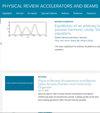一种抑制谐波自由电子激光器基波的简单方法
Physical Review Special Topics-accelerators and Beams
Pub Date : 2015-06-18
DOI:10.1103/PHYSREVSTAB.18.060703
引用次数: 3
摘要
谐波激光的初步研究表明,对于给定的电子能量和给定的波动体,谐波激光作为一种产生更高光子能量辐射的方法具有重要的前景。基本思想是抑制基本共振波长的辐射,并允许特定谐波的辐射以指数方式增长,而不受基本非线性过程的驱动。这有几个潜在的好处:在相同的波动场中,光子能量更高,与在基波达到饱和后提取谐波处的非线性辐射相比,功率更大,带宽更小。在本文中,我们使用LCLS-II当前设计的光束参数,对抑制基本波长辐射的挑战进行了批判性的研究,并评估了通过谐波激光在光子能量到达和亮度方面可以实现多少改进。对于具有可调磁场的波动器,提出了一种将基波长饱和的发生时间延迟2倍的方案。性能特性,特别是光谱亮度,与自播种波束线进行比较,作为减少带宽的替代方法,以及更传统的SASE波束线。本文章由计算机程序翻译,如有差异,请以英文原文为准。
Simple method to suppress the fundamental in a harmonic free electron laser
Preliminary studies of harmonic lasing have shown significant promise as a method to produce radiation at higher photon energies for a given electron energy and for a given undulator. The basic idea is to suppress radiation at the fundamental resonant wavelength, and allow radiation at a specific harmonic to grow exponentially without being driven by nonlinear processes at the fundamental. This has several potential benefits: higher photon energies for the same undulator field, plus significantly more power and smaller bandwidth compared to extracting nonlinear radiation at the harmonic after the fundamental has reached saturation. In this paper, we use beam parameters from the current design of LCLS-II to take a critical look at the challenge of suppressing radiation at the fundamental wavelength and to evaluate how much of an improvement in terms of photon energy reach and brightness can be achieved through harmonic lasing. For undulators with adjustable magnetic fields, a scheme is presented which can delay the onset of saturation at the fundamental wavelength by a factor of 2. Performance characteristics and especially spectral brightness are compared to self-seeded beam lines as an alternative method to reduce bandwidth, as well as with more conventional SASE beam lines.
求助全文
通过发布文献求助,成功后即可免费获取论文全文。
去求助
来源期刊
自引率
0.00%
发文量
0
审稿时长
3-8 weeks
期刊介绍:
Physical Review Special Topics - Accelerators and Beams (PRST-AB), is a peer reviewed, purely electronic journal, distributed without charge to readers and funded by contributions from national laboratories. It covers the full range of accelerator science and technology: subsystem and component technologies, beam dynamics; accelerator applications; and design, operation, and improvement of accelerators used in science and industry. This includes accelerators for high-energy and nuclear physics, synchrotron radiation production, spallation neutron sources, medical therapy, and intense beam applications.

 求助内容:
求助内容: 应助结果提醒方式:
应助结果提醒方式:


